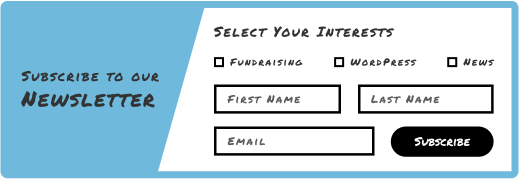Writing a readable email is the first step toward successful email marketing for nonprofits.
Implementing a nonprofit email newsletter is a critical part of your overall marketing strategy. This guide will help you generate new subscribers and create a newsletter that your supporters will be excited to receive.
First, take a moment and ask yourself:
- Does your organization create a newsletter that can stand out in a crowded inbox?
- Will the subject line entice people to open it?
- Does the content keep them interested?
- Are you enticing website visitors to subscribe with a unique proposition?
If you answered no to any of the above, then it is time to take some action. Below are some email marketing strategies and tips that will help grow your subscriber list and improve your open rates.
Why A Nonprofit Email Newsletter Is Important
When you keep your donors and supporters informed, it keeps your organization in their minds. A newsletter is the perfect opportunity to share organizational updates and success stories which makes your subscribers feel more connected.
It is also one of the most cost-effective and best converting options.
In 2020, email open rates for nonprofit organizations averaged 25.5% in a study done by CampaignMonitor. Compare that with social media engagements, which can be less than 2% in most cases, and you can see why having a mailing list is so important.
An email newsletter can include organizational updates, funny stories or fundraising marketing updates. The options for your content are limitless!
Creative Ways To Build Your Subscriber List
The best way to grow your email list is to put out engaging content. That will keep current subscribers from leaving. They may even share your content to others who will then subscribe. Make sure there is a social share and email link on every newsletter to encourage sharing.
Below are a few ideas for growing your mailing list.
1. Lead Magnets
A lead magnet is an offer of value that you will provide to visitors when they subscribe to your newsletter. Providing value at the start of your relationship is one of the most successful ways to grow your mailing list.
Below are some lead magnet ideas:
- White Papers
- Webinars
- Videos
- Case studies
- Success stories
- Podcast episodes
- Infographics
- Toolkits
Testing different lead magnets will help you identify what resonates most with your website visitors. You can run one lead magnet for 30 days and another for the next 30 days. Then compare the mailing list opt-in rates to see which was better.
Alternatively, you can do A/B testing to compare 2 lead magnets at the same time. Testing is an important part of improving your newsletters and getting the most out of this marketing channel.
2. Blogging
Every organization should be blogging. This is a great way to not only keep visitors engaged on your website but it can also help you be found in the search results.
When someone lands on your blog post and reads your content, it gives you the opportunity to make them want to be a part of your organization. When you create great content that is engaging and useful you will increase the chance of someone subscribing to your newsletter.
At the end of every blog post, include a mailing list sign up form. If they make it to the end of the blog post, that is a good sign they liked what they read. This will make the chance of them converting to a subscriber much more likely.
Like What You're Reading? Subscribe Here!
Newsletter Opt-in
3. Donation Form Opt-ins
Donation forms are one of the best ways to convert donors to newsletter subscribers.
If a visitor has made it through your donation form, they are clearly interested in your mission. This is the perfect opportunity to get them added to your mailing list.
Many donation tools, including GiveWP, have the option to include a checkbox to confirm they want to be added to your mailing list. Adding this to every donation form on your website can bring great results.
GiveWP makes this easy with their marketing add-ons. They offer mailing list add-ons for Aweber, Convert Kit, Active Campaign, and Mailchimp. These add-ons make the donor to mailing list subscriber process easy.
Below is an example of how this feature looks with a GiveWP form.

Creating An Engaging Subject Line
Subject lines are one of the most important parts of your newsletter. But they’re also tne part that many spend the least amount of time crafting.
Increasing the number of people who open your newsletter is related to how enticing your subject line is. So, we highly recommend you take a few extra minutes to brainstorm with others. Brainstorming helps you craft a more effective subject for your email newsletter.
A few tips for creating subject lines that will make people click include:
- Time Sensitive: By using dates and deadlines you can create a sense of urgency that will increase the chance of your newsletter being opened.
- Make It “Punny”: Make it lighthearted or you can even try to be “punny” which may not only make them giggle, but also make them curious about what is inside.
- Keep It Short: Subject lines that are too long will not be effective as they may not be seen in full. Keeping it to about 45 characters will improve the chance of it being eye-catching.
- Statistics: By using statistics or numerical values it makes recipients curious and want to learn more about the
- Exclusivity: Make subscribers feel special with a subject line that makes them feel like a real part of the community. Special events or information are a great way to make them feel special.
- Ask A Question: We are curious creatures and when a question is asked, most people will be intrigued and want to know the answer, which of course will be in your email.
An emoji can also add some visual impact that can make your newsletter stand out in a crowded inbox.

Avoid using terms like “newsletter” in your subject line, unless you want to decrease your chances of it being opened. Your subject line should be a teaser to all the goodness that awaits inside.
Be sure to ask others in your organization for ideas and to get feedback before clicking that send button.
Formatting Your Newsletter
The content of your newsletter should be aligned with the subject line, but you can add other content as well. If you are adding several content items be sure to make the subject line related content at the top of the email so readers can easily find it.
Below are some quick tips for creating a well designed newsletter.
- Make sure your branding is front and center with your logo and brand colors used throughout the newsletter.
- Include social sharing and newsletter links so it can be easily shared.
- Use white space between different sections or topics so readers can easily skim content.
- Make sure your font choice is easy to read and do not use less than a 16px font size.
- Ensure it is ADA compliant so that those with vision impairments can read it.
- Use section headers with larger and bolder fonts to section off content.
- Use background colors to break up sections if you have various content areas.
- Use a minimal number of images and be sure to optimize them for the web to prevent loading issues on various networks.
- View it on mobile devices before you send it so you can be sure it looks good on small devices.
We recommend having several team members review the newsletter before sending to get feedback and suggestions.
Email Segmentation For Nonprofits
When you segment (or group) list members it allows you to deliver more relevant content to your email subscribers based on their interests. You can tailor your messaging to different groups which can result in higher engagement and open rates.
Some segment examples include:
- Volunteer level
- Geographic location
- Donor level
- Frequency of donors
- Event attendees
- Mission focus
We always recommend having one main general mailing list that will have all of your subscribers and then creating groups within that list. You can also customize your subscribe form to allow subscribers to choose the segments they would like to receive information about.
An example of a well segmented list option is a musical nonprofit that offers 3 different types of programs. They offer subscribers the opportunity to select which program(s) they would like to receive email communication for.
This minimizes the risk of losing subscribers due to receiving emails with content they are not interested in.

Get More Nonprofit Marketing Tips!
Implementing these nonprofit marketing tips to your fundraising newsletter should bring great results in engagement metrics. All of the email marketing ideas here can be implemented with ease and are sure to make the readers excited for your next email to arrive.
For more tips to help boost your nonprofit marketing efforts, sign up for the GiveWP Nonprofit Newsletter.


